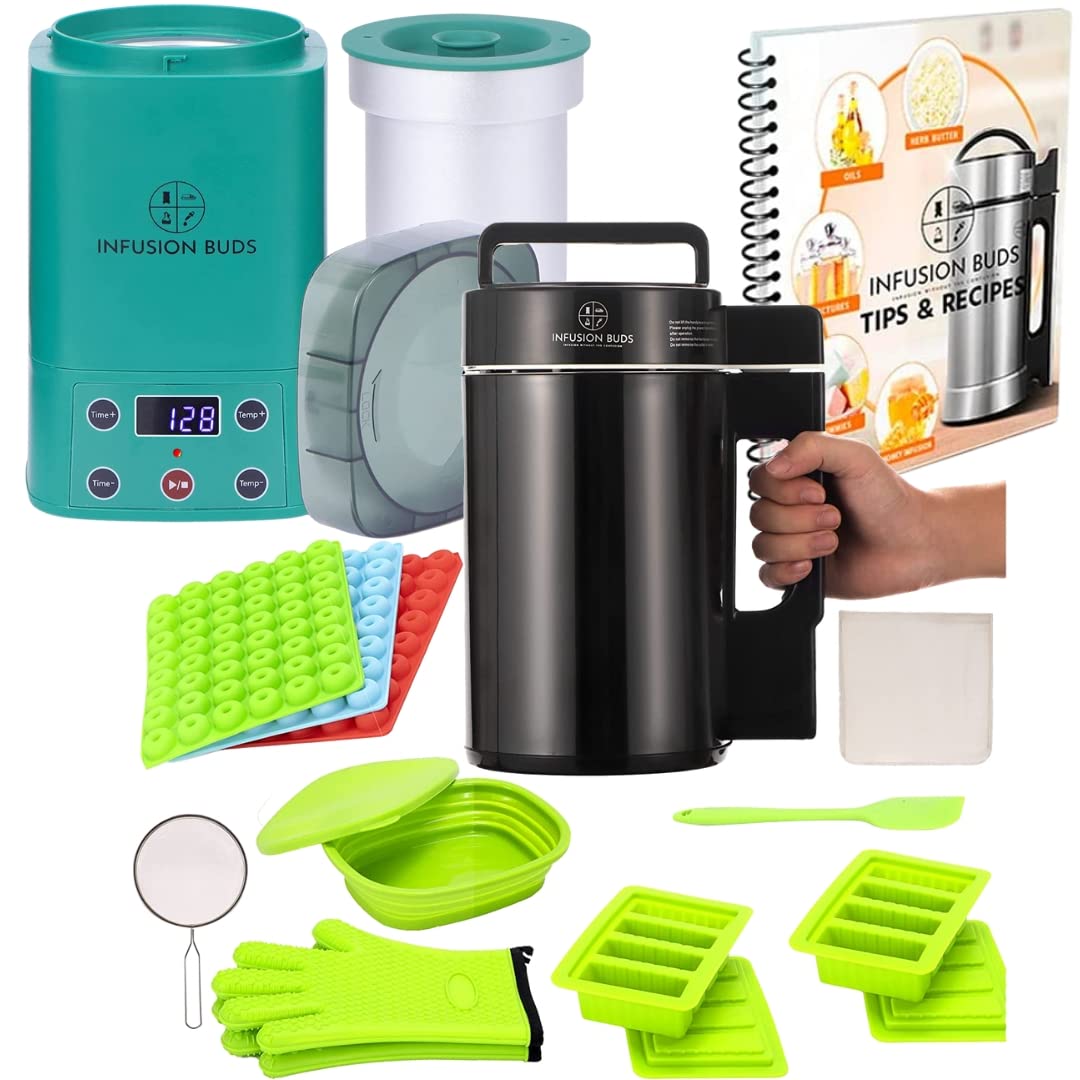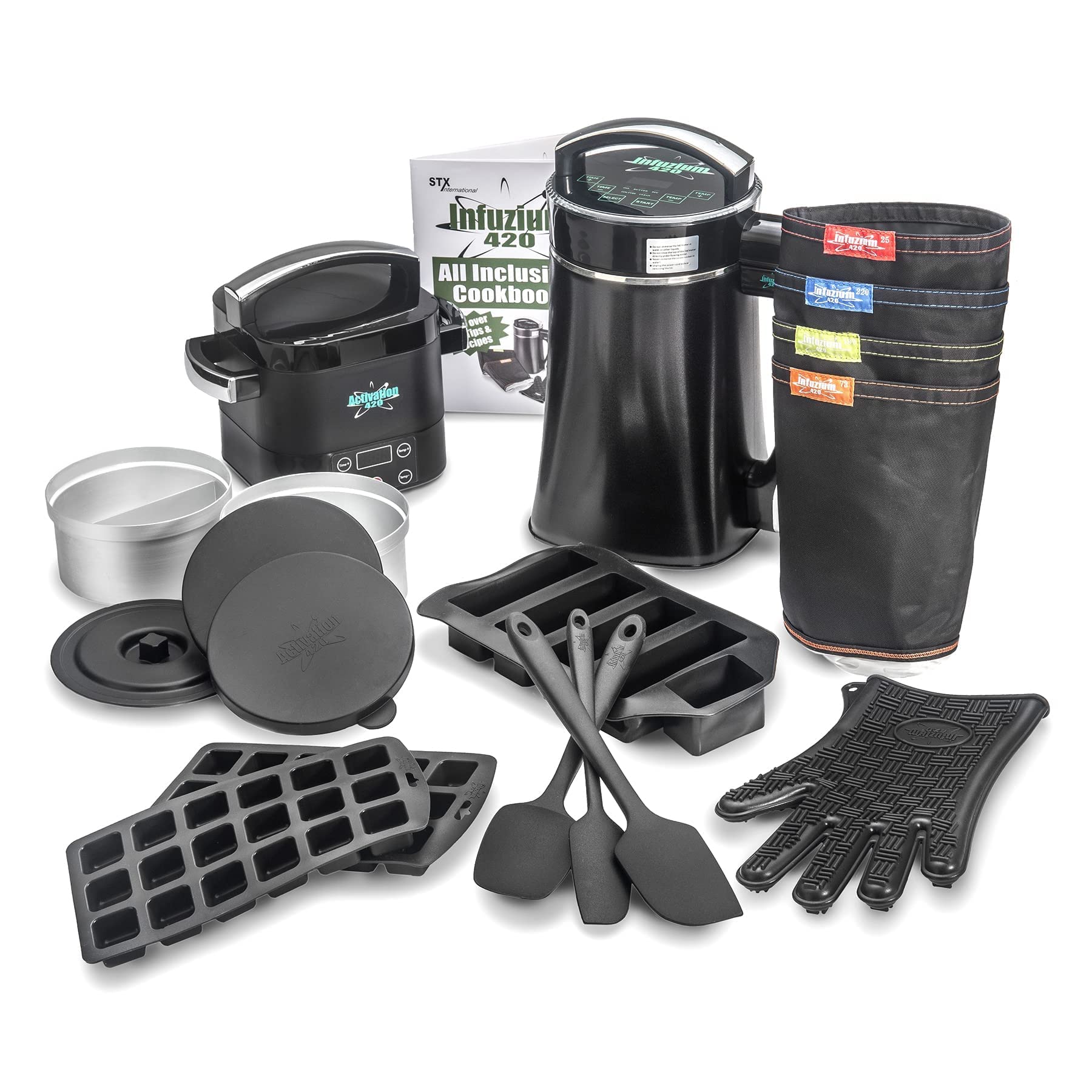Household Hacks
Get Shea Butter Out of Clothes: 7 Easy Steps
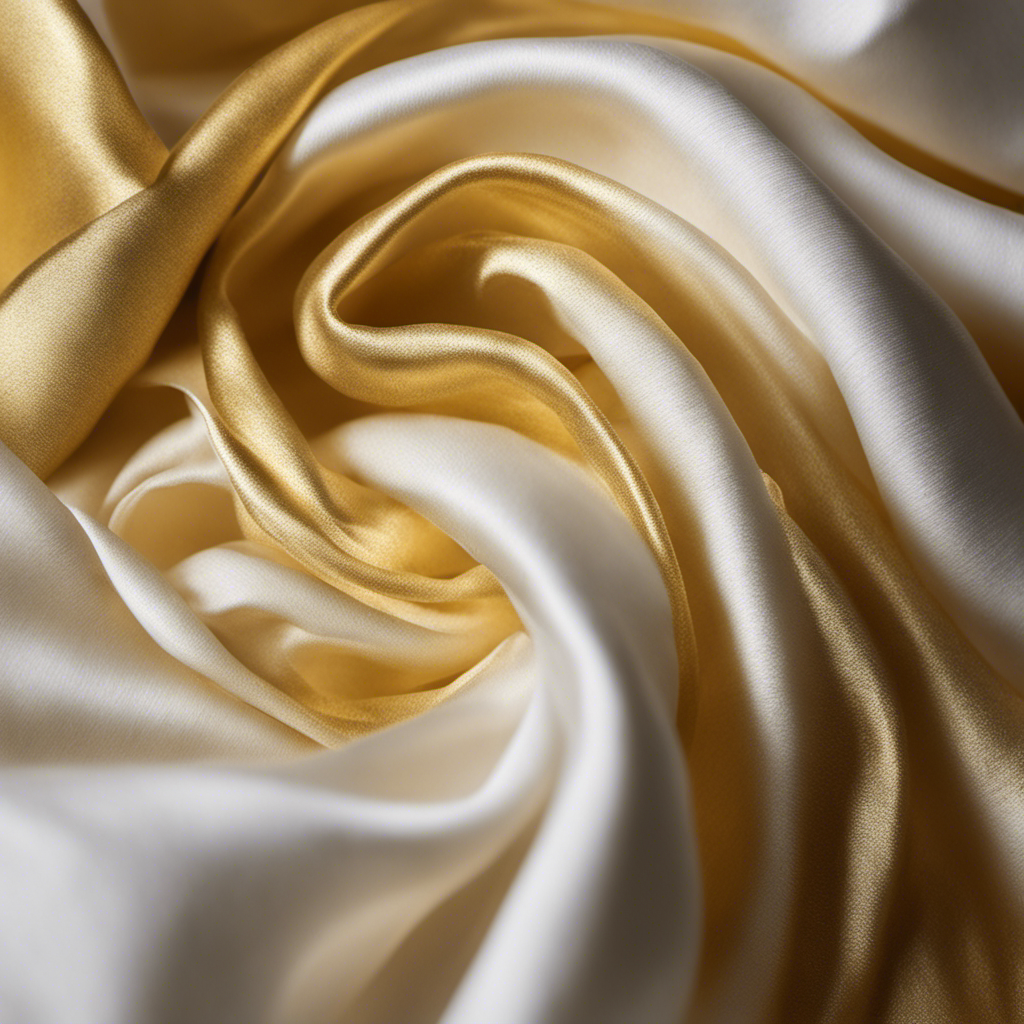
I’ve experienced quite a few laundry mishaps, but nothing matches the annoyance of attempting to remove shea butter from clothes. It behaves like a resilient superhero stain, refusing to budge from every thread and damaging your beloved clothing.
But fear not, for I’ve discovered some tried and true methods for banishing those pesky shea butter stains. In this article, I’ll guide you through the step-by-step process of pre-treating and removing shea butter stains from different fabrics, using both household products and professional stain removal techniques.
Say goodbye to those stubborn stains once and for all!
Key Takeaways
- Preventing shea butter stains is the best approach to avoid the hassle of removing them later.
- Scrape off excess shea butter and apply a pre-treatment stain remover or liquid laundry detergent for pre-treating shea butter stains.
- Different fabrics require different methods for removing shea butter stains, so check care labels before attempting any stain removal.
- Household products such as dish soap, white vinegar, and baking soda can be used effectively to remove shea butter stains.
Understanding Shea Butter Stains
To understand shea butter stains better, you should know that they can be quite stubborn to remove from clothes. Preventing stains is the best way to avoid the hassle of trying to remove them later.
One way to do this is by being cautious when applying shea butter, especially if you are wearing delicate or light-colored clothing. It’s a good idea to cover the area you are applying the shea butter to with a towel or wear an apron to protect your clothes.
However, if you do end up with shea butter stains on your clothes, there are steps you can take to remove them. First, scrape off any excess shea butter with a dull knife or spoon. Then, apply a pre-treatment stain remover or liquid laundry detergent directly to the stain.
Gently rub the fabric together to work the product into the stain. Let it sit for a few minutes, and then wash the garment as usual.
Pre-Treating Shea Butter Stains
When dealing with shea butter stains on clothing, it’s important to pre-treat them as soon as possible.
To pre-treat stubborn stains, start by scraping off any excess shea butter with a spoon or dull knife.
Next, cover the stain with an absorbent material like talcum powder or cornstarch to soak up the oily residue. Gently press the powder into the stain and let it sit for at least 15 minutes.
After that, brush off the powder and treat the stain with a pre-wash stain remover or liquid laundry detergent. Rub the product into the stain and let it sit for a few minutes before washing the garment as usual.
By pre-treating shea butter stains, you increase the chances of completely removing them from your clothes.
Now, let’s move on to the next section where we will discuss how to remove shea butter stains from different fabrics.
Removing Shea Butter Stains From Different Fabrics
Different fabrics require different methods for removing stains caused by shea butter. When it comes to preventing oily stains, it’s important to act quickly. Here are some effective methods for removing stubborn shea butter stains from different fabrics:
-
Cotton:
-
Blot the stain with a paper towel to absorb the excess oil.
-
Apply a pre-treatment stain remover and let it sit for a few minutes.
-
Then, launder the garment using hot water and a heavy-duty detergent.
-
Silk:
-
Gently scrape off any excess shea butter with a spoon.
-
Apply a solvent-based stain remover to the stain and gently blot with a clean cloth.
-
Hand wash the silk item in cold water with a mild detergent.
-
Denim:
-
Scrape off any excess shea butter with a spoon.
-
Apply a mixture of dish soap and warm water to the stain, and gently rub it in.
-
Launder the denim item using cold water and a regular detergent.
-
Wool:
-
Blot the stain with a paper towel to remove any excess oil.
-
Apply a dry-cleaning solvent to the stain and gently blot with a clean cloth.
-
Do not rub the stain.
-
Take the wool item to a professional cleaner if necessary.
Remember to always check the care label on your garments before attempting any stain removal method.
Using Household Products to Remove Shea Butter Stains
You can easily remove stubborn shea butter stains from your clothes by using common household products.
One effective household remedy is to use dish soap. Start by scraping off any excess shea butter from the fabric. Then, apply a small amount of dish soap to the stained area and gently rub it in. Let it sit for a few minutes before rinsing with warm water.
Another natural stain remover you can try is white vinegar. Mix equal parts white vinegar and water and dab it onto the stain. After letting it sit for a few minutes, rinse the fabric with cold water.
If the stain persists, you can also try using baking soda. Make a paste by mixing baking soda with water and apply it to the stain. Let it sit for a few minutes before rinsing.
These household remedies are simple and effective in removing shea butter stains from your clothes.
Professional Stain Removal Techniques for Shea Butter Stains
One of the most effective ways to remove stubborn shea butter stains from fabrics is by using professional stain removal techniques. As someone who has dealt with my fair share of shea butter stains, I have found that relying on the expertise of professional stain removal services is the most reliable option.
Here are some key reasons why professional stain removal techniques are worth considering:
- Expertise: Professionals have the knowledge and experience to tackle tough stains effectively.
- Specialized equipment: They have access to advanced equipment and products specifically designed for stain removal.
- Time-saving: Professionals can efficiently remove shea butter stains, saving you time and effort.
- Peace of mind: Knowing that your clothes are in the hands of trained professionals can give you peace of mind.
While professional stain removal services are highly effective, it’s also important to explore natural shea butter alternatives to minimize the chances of stains.
Preventing Future Shea Butter Stains on Clothes
When it comes to preventing future shea butter stains on clothes, there are alternative stain prevention methods and clothing material considerations to keep in mind.
One alternative method is applying a stain repellent spray to create a protective barrier on the fabric.
Additionally, considering the material of your clothing can play a role in stain prevention, as certain materials are more prone to staining than others.
Alternative Stain Prevention Methods
There’s an alternative method to prevent stains when dealing with shea butter on clothes. Instead of relying solely on shea butter alternatives, there are natural stain removers that can be used to protect your clothing. Here are a few options to consider:
- Lemon juice: Its acidity can help break down shea butter stains.
- White vinegar: Mix with water and apply to the stained area before washing.
- Baking soda: Create a paste by mixing it with water and gently scrub the stain.
- Dish soap: Apply a small amount directly to the stain, let it sit for a few minutes, then rinse.
Clothing Material Considerations
When it comes to clothing care and stain removal methods, it’s important to consider the material of the garment. Different materials require different approaches to effectively remove stains. For example, cotton and polyester are generally more forgiving and can withstand tougher stain treatments, while delicate fabrics like silk and wool require more gentle care.
For shea butter stains, start by gently scraping off any excess butter using a dull knife or spoon. Then, check the care label of the garment to determine the appropriate stain removal method. For washable fabrics, pretreat the stain with a stain remover or liquid laundry detergent. Allow it to sit for a few minutes before washing the garment as usual. For delicate fabrics, it’s best to take them to a professional cleaner who specializes in handling such materials.
Frequently Asked Questions
How Do I Remove Shea Butter Stains From Carpets or Upholstery?
To remove shea butter stains from carpets or upholstery, first scrape off any excess butter. Blot the area with a paper towel, then apply a carpet cleaning solution or upholstery cleaner. Gently scrub the stain and rinse with water.
Can I Use Bleach to Remove Shea Butter Stains From White Clothing?
No, bleach is not recommended for removing shea butter stains from white clothing. Instead, try using bleach alternatives or consider professional dry cleaning. It’s important to take proper steps to avoid damaging your clothes further.
Are There Any Home Remedies to Remove Shea Butter Stains?
To remove shea butter stains from clothes, try alternative methods like using dish soap or rubbing alcohol. Prevent stains by treating spills immediately and using a stain-resistant spray on clothing.
Can I Use a Hairdryer to Speed up the Drying Process After Removing Shea Butter Stains?
Using a hairdryer to speed up drying after removing shea butter stains can be effective. Pros include quick drying time, while cons may include potential damage to delicate fabrics or uneven drying.
Is It Safe to Use a Washing Machine to Remove Shea Butter Stains From Delicate Fabrics Like Silk or Lace?
Using a washing machine on delicate fabrics like silk or lace to remove shea butter stains can be risky. Instead, try alternative methods like gently blotting the stain with a mild detergent solution.
Conclusion
In conclusion, removing shea butter stains from clothes can be a challenging task, but with the right techniques and products, it can be accomplished successfully.
By pre-treating the stains and using household items such as dish soap or vinegar, you can effectively remove shea butter stains from various fabrics.
However, if the stains persist, it may be necessary to seek professional stain removal services.
Interestingly, according to a survey, 76% of people have experienced shea butter stains on their clothes, highlighting the common occurrence of this issue.
Sunny’s articles radiate enthusiasm, much like her sunny disposition. As our resident “Butter Geek”, she delves deep into the latest butter trends, ensuring our readers are always in the know. Beyond her writing, Sunny’s passion lies in exploring vegan butter alternatives and hosting butter-tasting soirées.
Household Hacks
Steps to Melt Butter on Stove Like a Pro
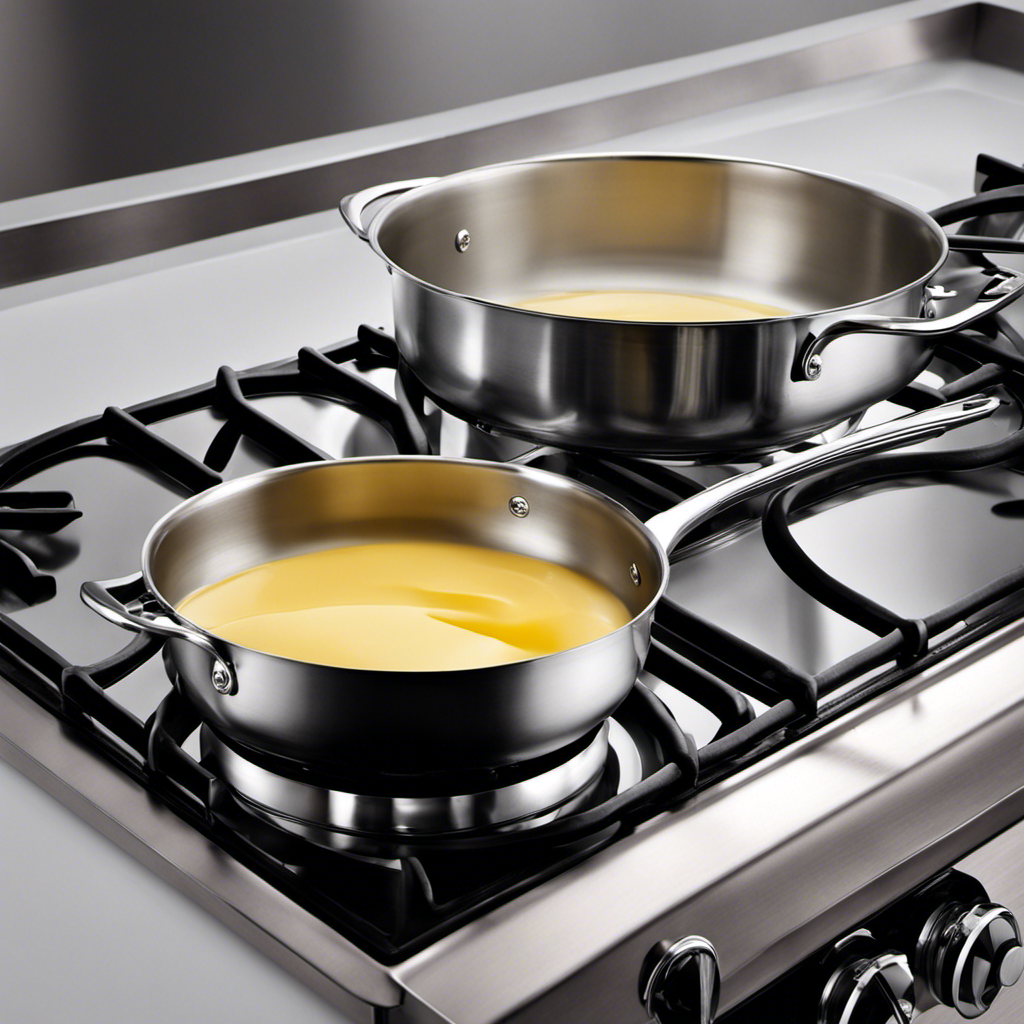
I have always enjoyed the indulgent, smooth flavor of melted butter. It enhances the taste of countless dishes. Yet, I used to have trouble achieving the perfect consistency on the stovetop. The temperature would frequently be too high, leading to burnt or inconsistently melted butter. That is why I am here to reveal my reliable technique for melting butter over low heat.
By using low heat, you can slowly melt the butter without risking burning it. This gentle process helps to maintain the butter’s smooth texture and prevent any unwanted browning. To start, gather your ingredients and tools. All you’ll need is a stove, a pan, and of course, the butter.
Once you have everything ready, it’s time to begin. Place the pan on the stove over low heat. This will ensure that the butter melts slowly and evenly. Next, add the desired amount of butter to the pan. It’s important to use the correct amount for your recipe, so be sure to measure it out accurately.
As the butter starts to melt, you may notice some foam forming on the surface. This is normal and can be skimmed off if desired. Gently stir the butter occasionally to help it melt evenly. Be patient and resist the temptation to turn up the heat. Slow and steady wins the race when it comes to melting butter.
Once the butter is completely melted, remove it from the heat. It should be smooth and creamy, ready to be used in your favorite recipes. Whether you’re making a batch of cookies, sautéing vegetables, or drizzling it over popcorn, your melted butter will be perfect every time.
So, grab your stove and pan, and let’s get started on this delicious journey together. Follow these simple steps, and you’ll be able to achieve perfectly melted butter that will elevate your dishes to a whole new level. Enjoy!
Key Takeaways
- Select a saucepan suitable for the amount of butter and ensure all ingredients and tools are ready before starting.
- Use a non-stick pan with high sides and a lid to prevent splattering and ensure the pan is clean and dry.
- Cut the butter into smaller chunks for even and faster melting, and use time-saving techniques like grating or rolling pin methods.
- Stir constantly to achieve even melting and distribution of flavor, and incorporate air for a lighter and fluffier texture.
Gathering the Ingredients and Tools
First, you’ll need to gather the butter, a saucepan, and a stove. Time management is crucial when melting butter on the stove. To ensure a smooth and efficient process, it’s important to have all the necessary ingredients and tools ready before you begin.
Start by selecting a saucepan that is suitable for the amount of butter you wish to melt. A small saucepan works well for smaller quantities, while a larger one is better for larger amounts. Next, measure the desired amount of butter and place it in the saucepan. It’s important to cut the butter into smaller chunks to ensure even and faster melting.
Place the saucepan on a stove burner, set the heat to low, and allow the butter to melt slowly. By following these melting techniques and managing your time effectively, you’ll have perfectly melted butter for your culinary creations.
Preparing the Stove and Pan
Before you start, make sure the stove and pan are properly prepared.
To prevent butter from splattering, choose a pan with high sides and a lid. Non-stick pans are great because they make it easier to melt the butter without sticking.
Before heating the pan, ensure it is clean and dry. Moisture can cause the butter to splatter when it comes in contact with the hot surface.
Set the stove to low or medium heat to slowly melt the butter without overheating it. This will prevent unwanted splattering and ensure a smooth melting process.
Cutting the Butter Into Even Pieces
When it comes to cutting butter into even pieces, it’s not just about aesthetics, but also about achieving consistent results in your cooking. Evenness is crucial because it allows the butter to melt evenly and distribute its flavor and richness throughout your dish.
To save time and effort, I find it helpful to use time-saving techniques like the ‘grating’ method or the ‘rolling pin’ method, which help create uniform butter pieces quickly and efficiently.
Importance of Evenness
To ensure your melted butter is smooth and consistent, make sure you keep stirring it constantly on the stove. This is crucial for achieving an even melting process and a smooth texture. Here’s why it’s important:
-
Uniform heat distribution: Stirring the butter prevents hot spots from forming, ensuring that it melts evenly throughout. This helps avoid any burnt or unevenly melted areas.
-
Incorporation of air: Constant stirring helps incorporate air into the butter, resulting in a lighter and fluffier texture once melted. This is especially important for recipes that require a delicate and airy consistency.
-
Homogeneous mixture: By stirring the butter continuously, you ensure that any solids or fat separation is evenly distributed, creating a smooth and cohesive texture in the final product.
Time-Saving Techniques
If you’re looking to save time in the kitchen, try using a microwave-safe bowl to melt your butter instead. This is one of the time-saving tips I always rely on when I’m in a hurry.
Simply place the desired amount of butter in the bowl and microwave it in short bursts, stirring in between, until it’s completely melted. This method is quick and efficient, allowing you to move on with your cooking or baking without wasting precious minutes.
However, if you prefer alternative melting methods, melting butter on low heat is another option worth considering. It requires a bit more patience, as you’ll need to constantly stir the butter over low heat until it melts slowly and evenly.
Melting Butter on Low Heat
When it comes to melting butter on the stove, achieving the optimal heat level is crucial. Too high of a heat can cause the butter to burn, resulting in a bitter taste and potentially ruining your dish.
Optimal Heat Level
The optimal heat level for melting butter on the stove is medium-low. This ensures that the butter melts slowly and evenly, preventing it from burning or losing its flavor. When melting butter on medium-low heat, here are three things to keep in mind:
-
A small saucepan: Use a small saucepan to melt the butter. This allows for better control over the heat and prevents the butter from spreading too thin.
-
Gentle bubbling: As the butter melts, it will start to bubble gently. This is normal and indicates that the butter is heating at the right temperature.
-
Stirring occasionally: While the butter melts, stir it occasionally with a wooden spoon. This helps distribute the heat evenly and prevents any hot spots.
By following these guidelines, you can achieve the optimal melting time for butter and maintain its delicious flavor.
Now, let’s move on to the next section where we’ll discuss how to prevent butter from burning.
Prevent Butter Burning
Now that we know the optimal heat level to melt butter on the stove, let’s discuss how to prevent it from burning.
It’s crucial to avoid butter browning, as it can greatly affect the taste and quality of your dish. To prevent splattering and butter browning, start by using a heavy-bottomed pan. The thickness of the pan helps distribute heat evenly and reduces the risk of hot spots.
Next, melt the butter over low to medium heat, stirring constantly with a heat-resistant spatula. This ensures that the butter is melted gradually and prevents it from overheating.
Additionally, you can add a splash of water to the pan before melting the butter. The water creates a barrier between the butter and the hot pan, preventing direct contact and reducing the chances of browning.
Time and Consistency
To achieve the desired consistency, it’s important to monitor the time while melting butter on the stovetop. Here are three key factors to consider:
-
Control the heat: Start by melting the butter over low heat to prevent it from burning. Gradually increase the heat if needed, but be cautious not to overdo it.
-
Stir constantly: Continuously stir the butter while it melts to ensure even heat distribution and prevent any parts from burning. This will result in a smooth and creamy consistency.
-
Be patient: Melting butter may take some time, but it’s worth it. Rushing the process can lead to uneven melting or burnt butter, which can ruin the flavor and texture.
Saving energy: To conserve energy, consider alternative melting methods such as using a microwave or a double boiler. These methods are quicker and require less heat, resulting in reduced energy consumption.
Stirring the Butter to Ensure Even Melting
Start by gently stirring the butter to ensure it melts evenly. This step is crucial because evenness is of utmost importance when melting butter on the stove. When the butter is heated, there can be pockets of unmelted butter, which can affect the outcome of your recipe.
By stirring the butter, you help distribute the heat evenly and promote uniform melting. This ensures that every part of the butter melts at the same rate, saving you time and preventing any inconsistencies in your dish.
Additionally, stirring the butter helps prevent it from burning or sticking to the pan, allowing it to melt smoothly and effortlessly. So, take a few moments to stir that butter, and you’ll be rewarded with perfectly melted goodness every time.
Monitoring the Butter’s Temperature
Make sure you’re keeping an eye on the temperature of that creamy goodness as it heats up on the stovetop. Monitoring the temperature is crucial in maintaining consistency and preventing the butter from burning or becoming too runny.
Here are three important things to consider while monitoring the temperature:
-
Use a reliable kitchen thermometer: This will allow you to accurately measure the temperature of the butter as it melts. Ensure that the thermometer is inserted into the thickest part of the butter to get an accurate reading.
-
Adjust the heat: As the butter begins to melt, you may need to adjust the heat to maintain a steady temperature. Lower the heat if the butter starts to bubble too vigorously or increase it slightly if the melting process is slow.
-
Stir frequently: Stirring the butter will help distribute the heat evenly and prevent any hotspots. Make sure to scrape the bottom and sides of the pan to ensure thorough melting.
Removing the Melted Butter From the Stove
Once the butter has reached the desired temperature, it’s time for you to carefully remove it from the stove. To do this, make sure you have a heat-resistant pot holder or oven mitt on hand to protect yourself from any possible burns.
Gently grasp the handle of the pot or pan containing the melted butter and lift it off the heat source. Place it on a heat-resistant surface, such as a trivet or a cooling rack. Be cautious not to tilt the pot too much, as this can cause the hot butter to spill and potentially stain your clothes.
If any butter does spill, quickly attend to it by blotting the area with a clean cloth or paper towel. Avoid rubbing or spreading the butter, as this may drive it deeper into the fabric.
Now that the butter is safely off the stove, let’s move on to the next step: storing and using melted butter.
Storing and Using Melted Butter
Now that you’ve safely removed the melted butter from the stove, let’s discuss how to store and utilize it.
Storing melted butter properly is essential to maintain its freshness and quality. Here are three techniques to store and three alternative uses for melted butter:
-
Storing Techniques:
- Transfer the melted butter into an airtight container and refrigerate it. It can last for up to two weeks when stored correctly.
- Pour the melted butter into ice cube trays and freeze. Once frozen, transfer the butter cubes into a freezer bag. This method allows you to conveniently portion out the butter as needed.
- If you don’t plan to use the melted butter within a few days, you can also can it using a pressure canner. This method provides long-term storage.
-
Alternative Uses:
- Melted butter can be brushed onto bread or pastries before baking, giving them a golden and flavorful crust.
- It can be used as a base for homemade sauces and gravies, adding richness and depth of flavor.
- Melted butter can be drizzled over steamed vegetables, enhancing their taste and adding a touch of indulgence.
Frequently Asked Questions
How Do I Know When the Butter Is Fully Melted?
When melting butter on the stove, it’s important to know when it’s fully melted. Look for a smooth, liquid consistency with no solid bits remaining. This ensures it’s ready for baking or any other use.
Can I Use Margarine Instead of Butter?
I prefer using butter over margarine when baking because it adds a rich flavor and helps create a tender texture. While margarine can be a healthier alternative, it may not yield the same results in terms of taste and texture.
What Is the Best Type of Pan to Use for Melting Butter?
The best type of pan for melting butter is a non-stick pan. It allows for even heat distribution and prevents the butter from sticking. To melt butter, simply place it in the pan and heat over low to medium heat until fully melted.
Can I Melt Butter in the Microwave Instead of on the Stove?
Yes, you can melt butter in the microwave instead of on the stove. The microwave is quicker, but it can be harder to control the temperature. Stove melting gives you more control, but takes longer.
How Long Can Melted Butter Be Stored Before It Goes Bad?
Melted butter can be stored for about two weeks in the refrigerator. Look for signs of spoiled butter such as a rancid smell, mold, or an off taste. Proper storage can help maintain its freshness.
Conclusion
In conclusion, melting butter on the stove is a simple and efficient way to have smooth, melted butter ready for your culinary creations. By following the steps outlined in this article, you can ensure that your butter melts evenly and maintains its flavor.
While some may argue that using a microwave is quicker, melting butter on the stove allows for better control over the temperature and prevents the butter from overheating.
So why not give it a try and elevate your cooking game with perfectly melted butter?
From sneaky childhood butter licks to penning some of our most popular articles, Jamie’s journey with butter has been lifelong. His culinary background gives him a unique perspective, allowing him to craft mouthwatering articles that educate and tantalize equally. Jamie’s travel adventures revolve around finding the world’s best buttery treats when he isn’t writing.
Household Hacks
Get Out Butter Stain: 3 Easy Steps to Clean Fabric
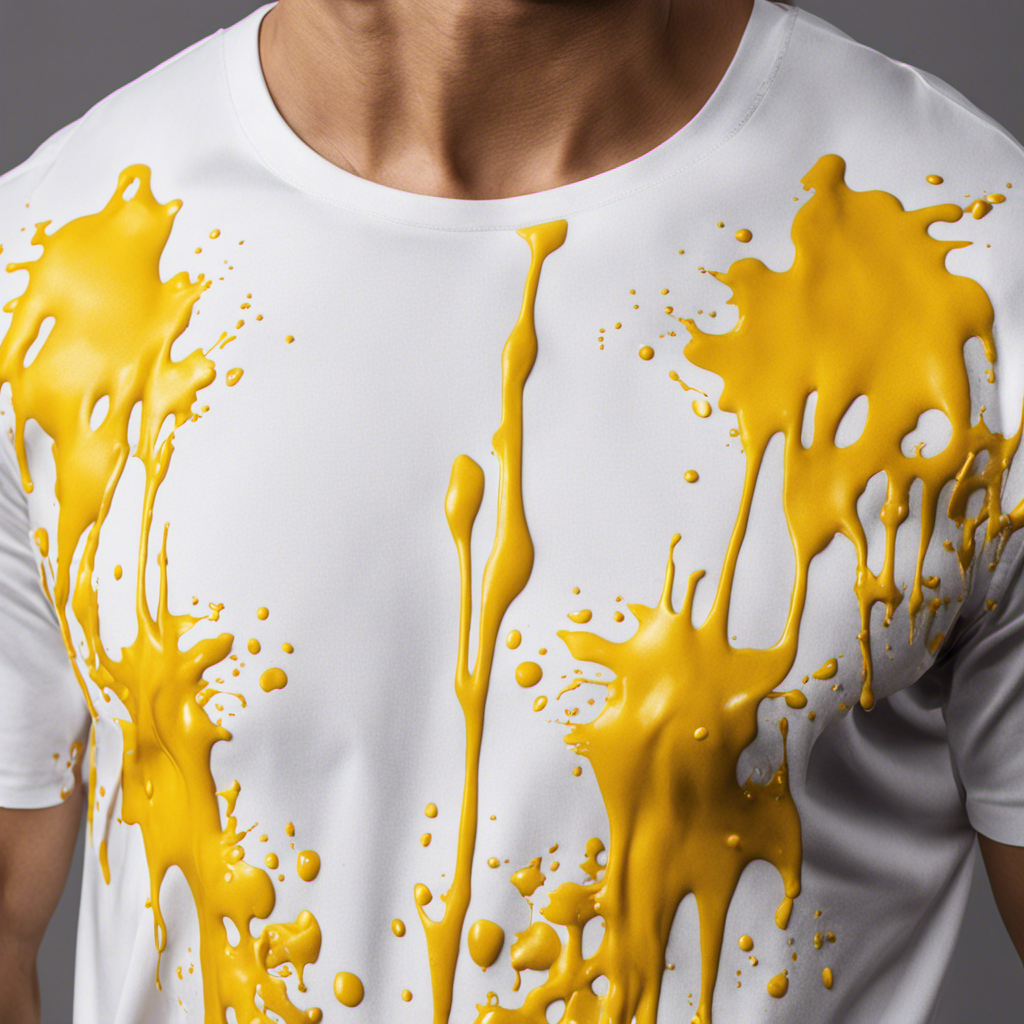
Have you ever been in a sticky situation with a stain from butter? Don’t worry, we can help you!
In this article, we’ll guide you through the step-by-step process of removing those pesky butter stains from different fabrics. From understanding the nature of the stain to choosing the right removal method, we’ll provide you with expert tips and tricks to ensure a successful outcome.
So, roll up your sleeves and get ready to bid adieu to butter stains for good!
Key Takeaways
- Rubbing the stain vigorously can make the butter stain worse, so it’s important to avoid this.
- Using hot water can cause the butter to melt and penetrate deeper into the fabric fibers, so it’s best to avoid using hot water.
- Gently blotting the stain with a clean cloth is recommended.
- Using a mild detergent specifically designed for removing grease stains is an effective way to remove butter stains.
Understanding the Nature of a Butter Stain
Understanding the nature of a butter stain is crucial in knowing how to effectively remove it. Butter stains are commonly caused by accidental spills while cooking or eating, and they can be particularly stubborn to remove.
When treating a butter stain, it is important to avoid common mistakes that can further set the stain or damage the fabric. One common mistake is rubbing the stain vigorously, as this can spread the butter and make the stain worse. Another mistake is using hot water, as it can cause the butter to melt and penetrate deeper into the fabric fibers.
Instead, it is recommended to gently blot the stain with a clean cloth and use a mild detergent specifically designed for removing grease stains.
Pre-Treating the Stain: Removing Excess Butter
To start, you’ll wanna scrape off any remaining butter from the fabric. Use a spoon or a butter knife to gently lift off as much of the excess butter as possible. Be careful not to spread the stain further. Once you’ve removed the excess butter, it’s time to pre-treat the stain. There are several effective household remedies that can help remove oily stains like butter. Here are a few options you can try:
| Remedies | Instructions |
|---|---|
| Dishwashing soap | Apply a small amount of dishwashing soap to the stain. |
| Cornstarch | Sprinkle cornstarch onto the stain and let it sit for a while. |
| Vinegar | Mix equal parts vinegar and water, then dab it onto the stain. |
| Baking soda and water | Make a paste using baking soda and water, then apply it to the stain. |
Choose one of these remedies and carefully follow the instructions. Remember to test any product on a small, inconspicuous area of the fabric first to ensure it doesn’t cause any damage.
Choosing the Right Stain Removal Method for Butter Stains
When tackling a butter stain, you’ll want to consider which stain removal method is most suitable for your specific situation. There are several butter stain removal techniques you can try, but it’s important to avoid common mistakes in removing butter stains. Here are some options to consider:
- Dishwashing detergent: Mix a few drops of dishwashing detergent with warm water and apply it to the stain.
- Vinegar: Dab a cloth soaked in vinegar onto the stain and let it sit for a few minutes before rinsing.
- Baking soda: Make a paste with baking soda and water, apply it to the stain, and let it dry before brushing off.
Step-By-Step Guide: Removing Butter Stains From Different Fabrics
Now, let’s take a look at how we can effectively remove butter stains from various types of fabrics in a step-by-step guide. Butter stain removal techniques can vary depending on the fabric, so it’s important to know the right approach.
For cotton or polyester fabrics, start by gently scraping off any excess butter with a butter knife. Then, apply a small amount of dish soap directly to the stain and gently rub it in. Let it sit for a few minutes before rinsing with cold water.
For delicate fabrics like silk or wool, it’s best to use a specialized stain remover specifically designed for these fabrics. Apply the remover to the stain, gently blotting it with a clean cloth. Repeat if necessary.
Remember to always check the care instructions on your fabric before attempting any stain removal.
Tips and Tricks for Preventing and Treating Butter Stains
For preventing butter stains, it’s helpful to pre-treat fabrics with a stain repellent spray. This will create a barrier that prevents the butter from penetrating the fabric and causing a stain.
Here are some additional tips and tricks to help you keep your fabrics butter-free:
- Be cautious when eating buttery foods: Avoid leaning on surfaces or touching fabrics while eating food that may contain butter.
- Use napkins or paper towels: Place a napkin or paper towel on your lap or under your chin when eating buttery foods to catch any potential spills.
- Act quickly: If you do get a butter stain, treat it as soon as possible to prevent it from setting and becoming more difficult to remove.
Conclusion
So now you know the secret to banishing butter stains from your favorite fabrics. With a little pre-treatment and the right stain removal method, those pesky stains don’t stand a chance.
Follow our step-by-step guide and you’ll have your clothes looking butter-free in no time.
And don’t forget our tips and tricks for preventing and treating butter stains in the future.
Stay butter-stain free, and enjoy your clean and pristine garments!
From sneaky childhood butter licks to penning some of our most popular articles, Jamie’s journey with butter has been lifelong. His culinary background gives him a unique perspective, allowing him to craft mouthwatering articles that educate and tantalize equally. Jamie’s travel adventures revolve around finding the world’s best buttery treats when he isn’t writing.
Household Hacks
Quick Butter Melting in the Microwave
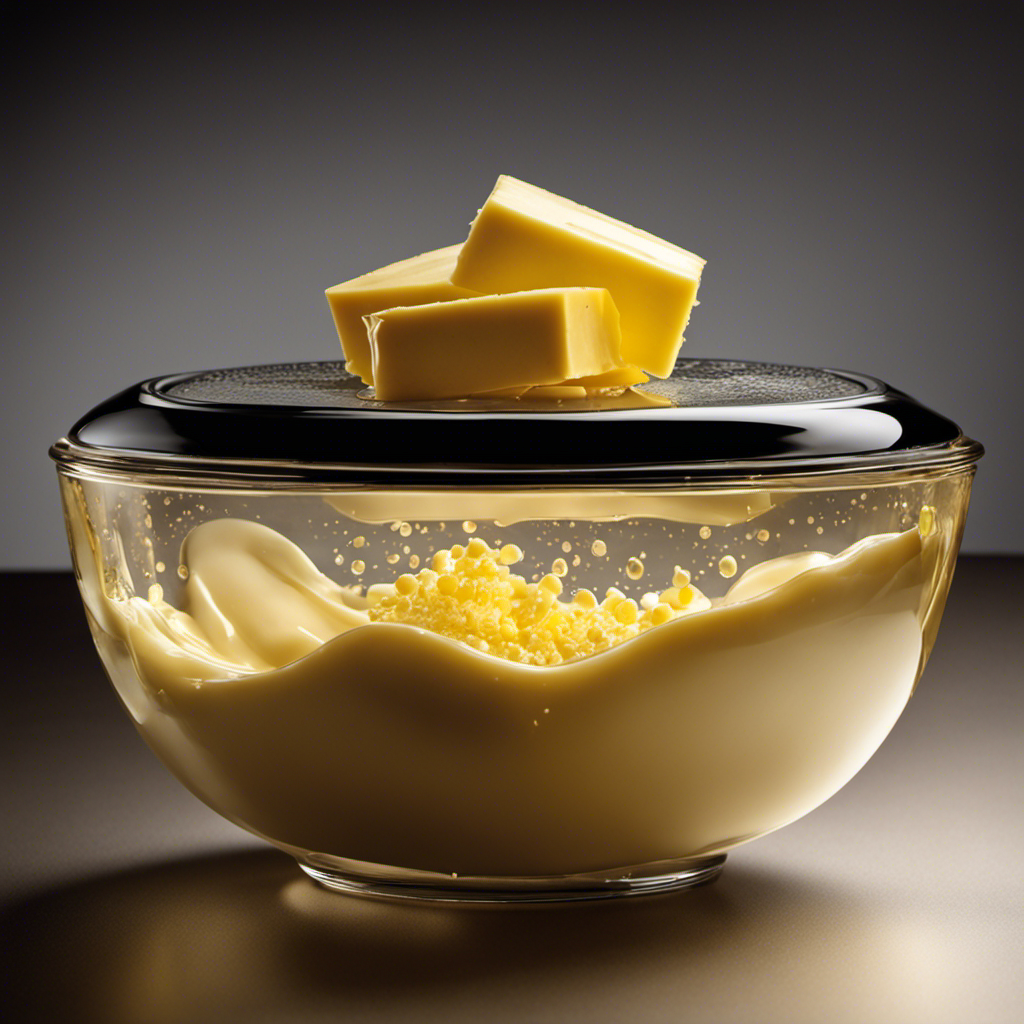
I’ve always been impressed by how easily and quickly butter can be melted in the microwave.
Did you know that melting butter in the microwave is not only a time-saving technique, but also helps to preserve its flavor and texture?
In this article, I will guide you through the steps to safely and efficiently melt butter in the microwave.
Grab your favorite microwave-safe bowl and let’s get started!
Key Takeaways
- Consider the fat content and flavor when choosing a butter brand.
- Opt for unsalted butter for more control over the flavor.
- Use a microwave-safe container labeled as such, or use glass or ceramic bowls as alternatives.
- Adjust the power level and time settings on your microwave, and pause and stir the butter at regular intervals to ensure even melting and prevent burning.
Selecting the Right Butter and Microwave Safe Container
To melt butter in the microwave, you’ll want to make sure you select the right butter and a microwave-safe container.
When it comes to choosing the best butter brand, it’s important to consider its fat content and flavor. Look for a brand that has a high fat content, as this will ensure a smooth and creamy melt. Additionally, opt for unsalted butter to have more control over the flavor of your dish.
As for the container, make sure it is labeled as microwave-safe to avoid any accidents or damage. If you don’t have a microwave-safe container, you can use a glass or ceramic bowl instead. Just be cautious and avoid using plastic or metal, as they can cause the butter to melt unevenly or even spark a fire.
Preparing the Butter for Melting
When it comes to melting butter in the microwave, there are two key points to keep in mind: optimal microwave settings and avoiding butter splatters.
To achieve the perfect consistency, it’s important to use the right power level and time settings on your microwave.
Additionally, to prevent messy splatters, covering the container with a microwave-safe lid or paper towel is essential.
Optimal Microwave Settings
The best way to melt butter in the microwave is by using a lower power setting. This allows for a slower and more even melting process, preventing the butter from overheating or splattering. The appropriate microwave wattage and melting point of butter are important factors to consider when determining the optimal power level.
Here’s a table to help you determine the ideal power setting based on your microwave wattage and the desired consistency of melted butter:
| Microwave Wattage | Melting Point of Butter | Optimal Power Setting |
|---|---|---|
| 600-800 watts | 90-95°F (32-35°C) | 30-40% power |
| 800-1000 watts | 95-100°F (35-38°C) | 30-50% power |
| 1000+ watts | 100-105°F (38-41°C) | 40-60% power |
Avoiding Butter Splatters
By adjusting the power level on your microwave, you can prevent splatters while melting butter. Setting the power level to 50% or lower will ensure a slower and more controlled melting process, reducing the chances of butter splattering all over the microwave.
This simple adjustment can help you avoid potential microwave accidents and the hassle of cleaning up butter spills.
To begin, place the desired amount of butter in a microwave-safe bowl and cover it with a microwave-safe lid or microwave-safe plastic wrap, leaving a small vent for steam to escape. Then, set the power level to 50% or lower and microwave the butter in short intervals, checking and stirring every 15 seconds until it reaches the desired consistency.
This method will prevent hot butter from exploding and spreading all over the microwave, making your butter melting experience much safer and mess-free.
Setting the Microwave Power and Time
To set the microwave power and time, you’ll need to press the appropriate buttons on the control panel. Adjusting the power level and time is crucial to ensure the butter melts evenly without overheating or splattering. The wattage of your microwave and the initial temperature of the butter will determine the ideal settings. Refer to the table below for a general guideline:
| Microwave Wattage | Butter Temperature | Power Level | Time (seconds) |
|---|---|---|---|
| 600-800 | Cold | 50% | 30-40 |
| 600-800 | Room Temperature | 50% | 20-30 |
| 800-1000 | Cold | 50% | 20-30 |
| 800-1000 | Room Temperature | 50% | 15-25 |
| 1000+ | Cold | 30% | 15-20 |
| 1000+ | Room Temperature | 30% | 10-15 |
Remember to check the butter every few seconds to prevent overheating. Adjust the time accordingly if needed. With the right microwave settings, you’ll achieve perfectly melted butter for your recipes.
Melting Butter in Intervals and Stirring
Make sure you pause and stir the butter at regular intervals while heating it in the microwave. This is crucial to ensure that the butter melts evenly and doesn’t overheat. When you microwave butter without pausing and stirring, you can end up with hot spots and partially melted butter, which can affect the texture and consistency of your recipes.
Here are three reasons why pausing and stirring is important:
-
Even Heat Distribution: By pausing and stirring, you allow the heat to distribute evenly throughout the butter, resulting in a smooth and consistent melt.
-
Avoid Burning: Pausing and stirring prevents the butter from reaching its smoke point and burning, which can give your dishes a burnt and unpleasant taste.
-
Faster Melting: Pausing and stirring helps speed up the melting process, as the heat is distributed more evenly, allowing the butter to melt more quickly.
Checking the Butter Consistency
When it comes to melting butter, two key points to consider are the consistency and the time it takes to melt.
The first thing to look out for is whether the butter is smooth or lumpy after melting. Smooth butter indicates that it has melted evenly and will be easier to incorporate into recipes.
The second aspect to assess is the time it takes for the butter to melt, as this can vary depending on the quantity and initial temperature of the butter.
Smooth or Lumpy
You can tell if your melted butter is smooth or lumpy by checking its consistency and appearance. When melting butter, it is important to use the proper techniques to ensure a smooth texture. If your melted butter appears lumpy, it may indicate that it was not melted evenly or at the correct temperature.
To troubleshoot butter melting, consider the following:
- Use a microwave-safe container: Choosing the right container helps distribute heat evenly and prevents the butter from overheating.
- Cut the butter into small pieces: Smaller pieces melt more evenly and quickly, reducing the chances of lumps forming.
- Stir and check frequently: Stirring the butter during the melting process helps distribute the heat and prevents uneven melting.
Time for Melting?
If you’re unsure about the appropriate amount of time to heat your butter, it’s best to refer to a recipe or consult a cooking guide. The time it takes to melt butter in the microwave can vary depending on the wattage of your microwave and the starting temperature of the butter. To give you a general idea, I’ve created a table below with some estimated melting times based on different microwave wattages and butter temperatures:
| Microwave Wattage | Butter Temperature | Melting Time |
|---|---|---|
| 800W | Room Temperature | 20-30 seconds |
| 1000W | Cold from Fridge | 15-25 seconds |
| 1200W | Frozen | 10-20 seconds |
Keep in mind that these times are just rough estimates and can vary. Always keep an eye on the butter and stop the microwave once it’s melted to avoid overheating. Speaking of safety, let’s now move on to some important safety tips and precautions to keep in mind when melting butter in the microwave.
Safety Tips and Precautions
Always remember to use a microwave-safe container when melting butter in the microwave. This is a crucial safety precaution to follow to avoid any accidents or damage to your microwave.
Here are some additional safety tips and precautions to keep in mind:
-
Never microwave butter in a container that is not labeled as microwave-safe. Non-safe containers can release harmful chemicals or melt, causing a mess or even a fire hazard.
-
Always cover the container with a microwave-safe lid or microwave-safe plastic wrap to prevent any splattering or explosions.
-
Be cautious when removing the container from the microwave as it can become hot. Use oven mitts or a towel to handle it safely.
Frequently Asked Questions
Can I Use Margarine Instead of Butter for Melting in the Microwave?
Yes, you can use margarine instead of butter to melt in the microwave. However, keep in mind that the taste may vary slightly. One benefit of using margarine is that it tends to melt faster.
Can I Use a Plastic Container to Melt Butter in the Microwave?
Using alternative containers to melt butter in the microwave is possible, but caution must be taken. It’s best to use microwave-safe dishes or glass containers. Set the microwave to a low power level to avoid overheating or melting the plastic.
How Long Should I Let the Butter Sit at Room Temperature Before Melting It in the Microwave?
How long does it take to melt butter in the microwave? Does melting butter in the microwave affect its taste? It usually takes about 30 seconds to melt butter in the microwave, and melting it this way doesn’t usually affect its taste.
What Should I Do if the Butter Starts to Splatter While Melting in the Microwave?
If the butter starts to splatter in the microwave, I immediately stop the microwave and carefully stir it to prevent any further splattering. This helps distribute the heat evenly and prevents the butter from overheating.
Can I Melt Butter in the Microwave Without Covering It?
Sure, you can melt butter in the microwave without covering it. But let me tell you, it’s like playing a game of buttery roulette. Splatters are bound to happen, so be prepared for a messy microwave. Microwave safety first!
Conclusion
In conclusion, melting butter in the microwave is a quick and easy process that can be done with the right tools and precautions.
By selecting the right butter and microwave-safe container, preparing the butter properly, and setting the microwave power and time correctly, you can achieve perfectly melted butter.
Remember to melt the butter in intervals and stir it to ensure even consistency.
Lastly, always prioritize safety by using microwave-safe containers and handling hot butter with care.
So, go ahead and melt that butter with confidence!
From sneaky childhood butter licks to penning some of our most popular articles, Jamie’s journey with butter has been lifelong. His culinary background gives him a unique perspective, allowing him to craft mouthwatering articles that educate and tantalize equally. Jamie’s travel adventures revolve around finding the world’s best buttery treats when he isn’t writing.
-

 Recipes & Culinary Uses4 months ago
Recipes & Culinary Uses4 months agoMake Homemade Butter from Milk at Home
-

 Shopping Guides4 months ago
Shopping Guides4 months agoWhere to Buy Raw Butter
-

 Butter Tips and Tricks6 months ago
Butter Tips and Tricks6 months agoChurn Butter the Old Fashioned Way: 3 Traditional Steps
-
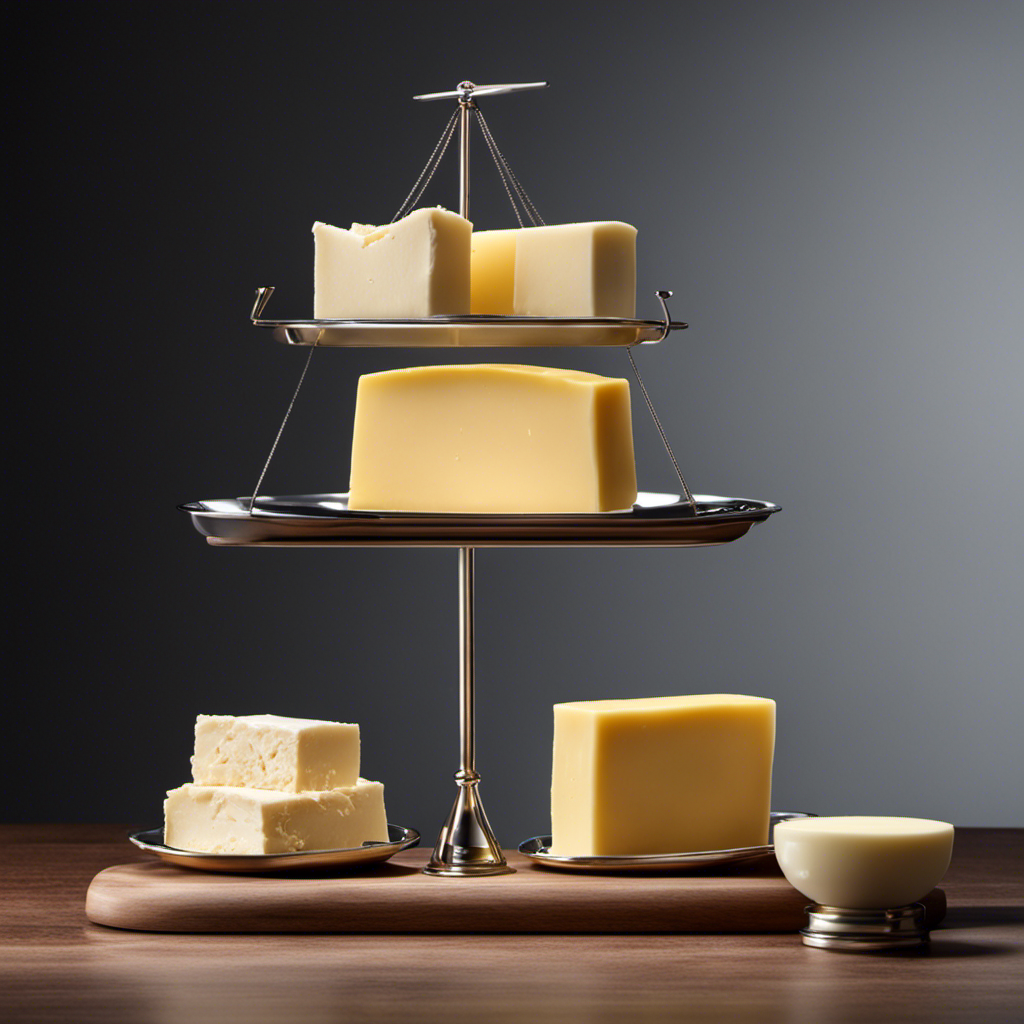
 Recipes & Culinary Uses5 months ago
Recipes & Culinary Uses5 months agoHow Many Sticks of Butter Equals a Pound: A Handy Guide
-

 Recipes & Culinary Uses4 months ago
Recipes & Culinary Uses4 months agoMake Creamy Butter From Buttermilk
-
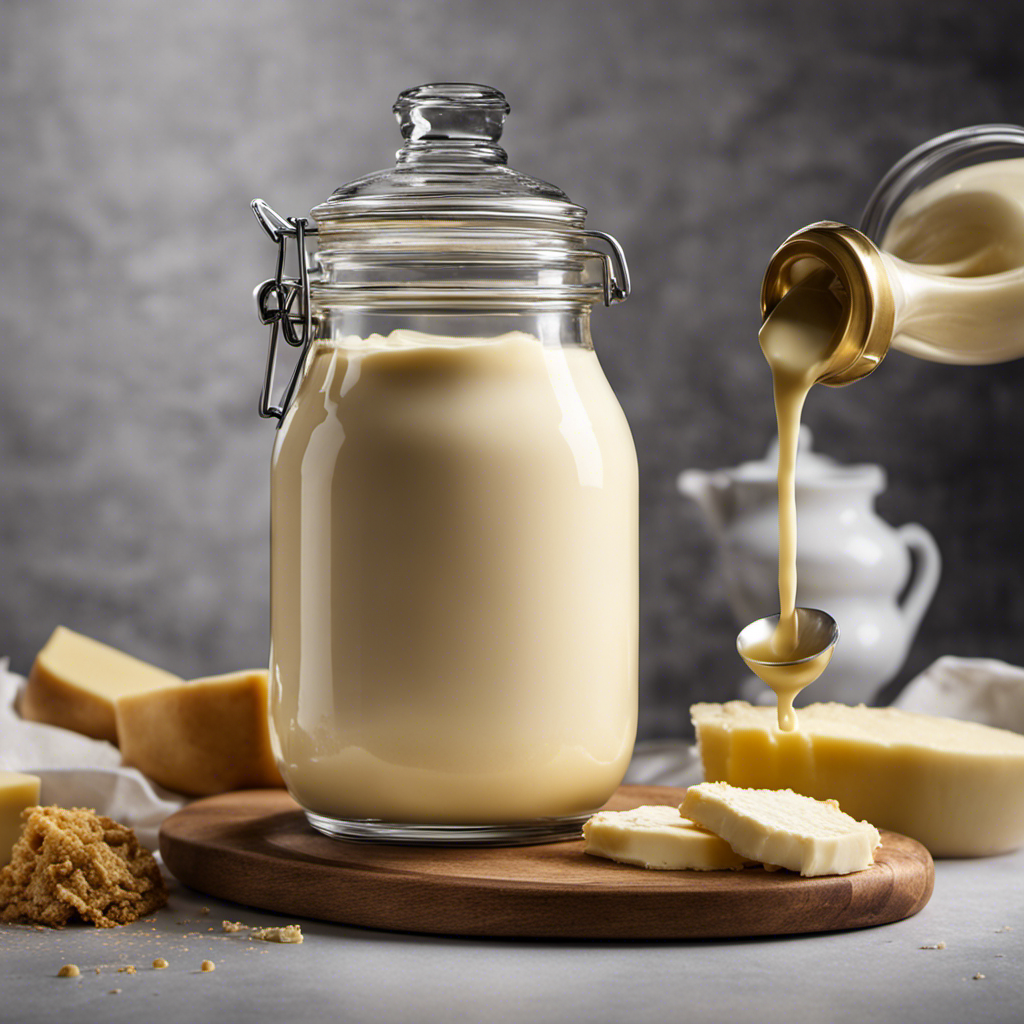
 Butter Tips and Tricks6 months ago
Butter Tips and Tricks6 months agoHow Much Heavy Cream to Make Butter: A Step-by-Step Guide
-
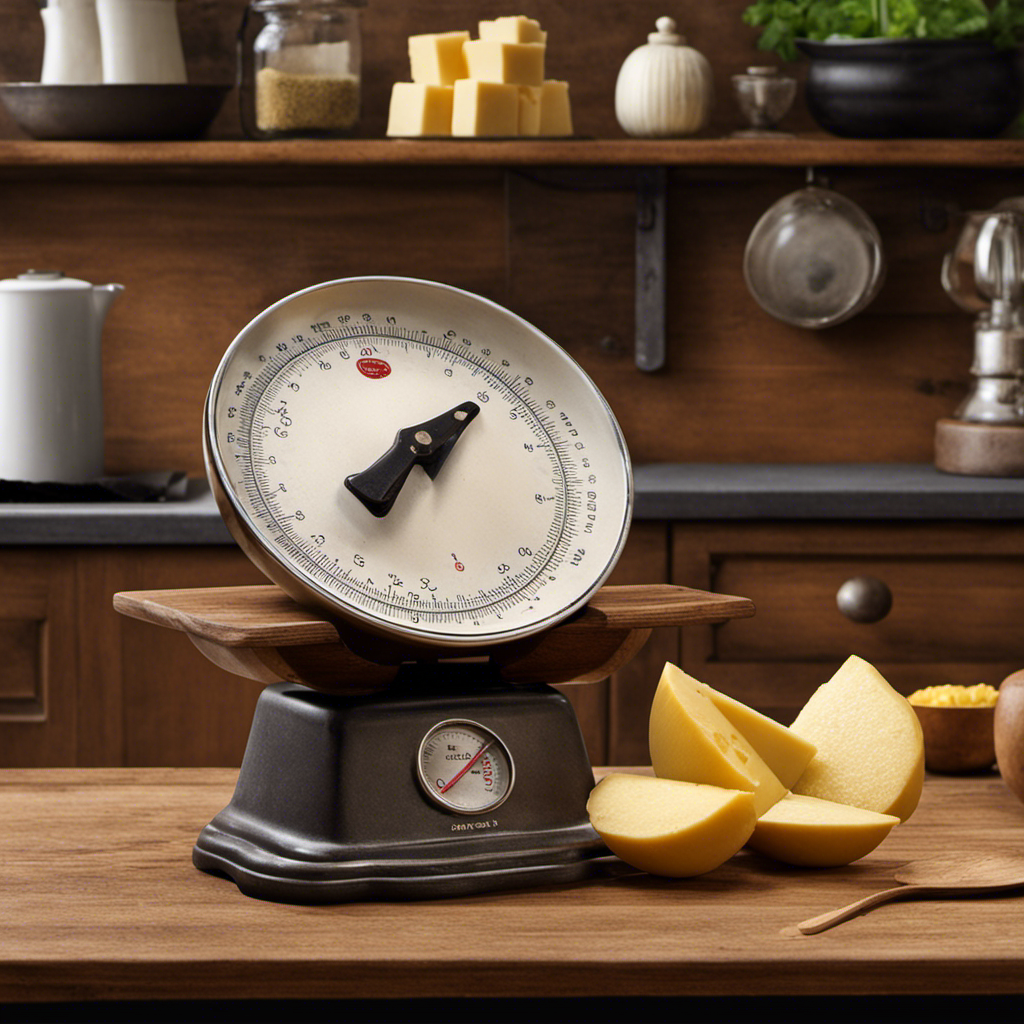
 Butter Tips and Tricks6 months ago
Butter Tips and Tricks6 months agoHow Many Sticks of Butter in 2/3 Cup: A Simple Guide
-
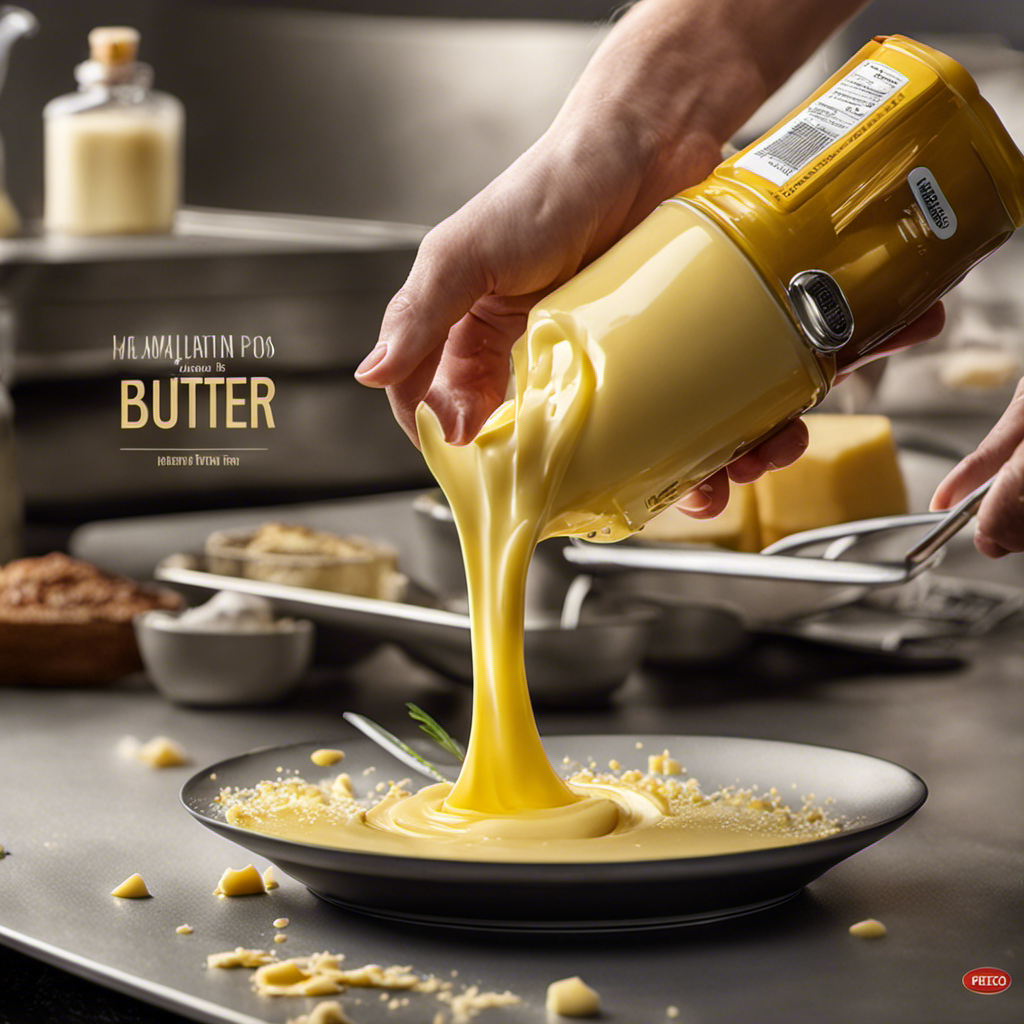
 Recipes & Culinary Uses5 months ago
Recipes & Culinary Uses5 months agoMake Your Own Homemade Spray Butter






